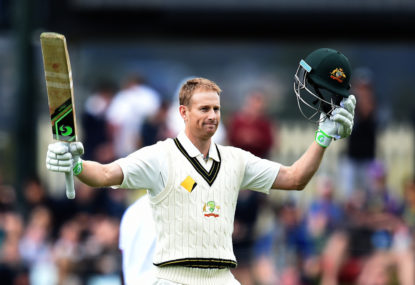We are presently watching the greatest batting talent in Australian cricket history.
Adam Voges is the second-best batsman ever after Don Bradman, averaging 95.50. Steve Smith is a better batsman than the great Greg Chappell, averaging 60.29 to 53.86.
David Warner is among the top four best-ever openers, after Bob Simpson, Bill Ponsford, Bill Woodfull (by only 0.01) and just ahead of Matthew Hayden.
Indeed, the current top five batsmen – Voges, Smith, Warner, Usman Khawaja and Joe Burns – are among the top 13 averages ever for Australian cricket. In 14th place is the recently retired Michael Clarke.
Why is all this so? Because the stats tell us it is so. But more importantly, do you believe this?
I certainly don’t. Perhaps if your cricket knowledge extends back only 10 years, or perhaps only to the new millennium, you might believe this.
But if your first-hand cricketing knowledge extends back 50 years, as mine does, and if you have an appreciation of Test cricket history dating back to 1877, as I have, then you won’t believe these figures for a nano-second.
Don’t get me wrong, Voges is a great bloke and an excellent batsman, but he is over-valued. I love Voges’ grit and gutsiness and the fact he has struck a blow for the ‘old timers’ and ‘late bloomers’. But second-best ever? No way.
Also, should we believe Smith is better than Chappell? Smith is a fine batsman and developing into a very good captain, once he gets rid of the ‘sooks’. But having seen both live, Chappell is much better.
Chappell, who played 87 Tests, had to face some outstanding bowlers in his time – Derek Underwood (24 Tests), Bob Willis (23), Tony Greig (21), John Snow (14), Richard Hadlee and Sarfraz Nawaz (both 13), Lance Gibbs, Mike Holding, Ian Botham and Imran Khan (each 11) and Andy Roberts and Ray Illingworth (both 10).
Most of these players would make their country’s best XI for the past 50 years. Indeed, Greig, Botham, Snow, Underwood and Willis would comprise my best England bowling attack of the past 50 years.
It’s instructive that the so called ‘top five’ have all averaged better than 55 against New Zealand in all Tests, while Khawaja and Smith have all averaged in excess of 100 against the Windies, with Voges almost 70.
Yet none of them have averaged 50 against England in all Tests, although Burns is yet to face the ‘old enemy’. But surprisingly, Smith is the only one to cash in heavily against India, with Warner and Burns the only other two to face India.
England’s current fifth Test ranking makes a mockery of their recent good form. I believe they have the second-best Test bowling attack after Australia.
Many people will argue that most of the advantages lie with the modern batsman. While the ball technology has changed little in 140 years, the bat has undergone significant changes.
Bats are today both lighter yet stronger, with a much greater sweet spot. An errant nick will quickly run away to the boundary.
Pitches are much better prepared and outfields beautifully manicured. Boundaries have been shortened and protective equipment has removed the fear factor.
Governing authorities also demand pitches that last the full five days, thus maximising revenue form attending patrons and TV programming.
Another advantage is the proliferation of two-Test series and the massive reduction in five- and four-Test series. This makes it more difficult for bowlers to work out a batsman’s technique in just a couple of Tests.
Perhaps the only factor in favour of the bowler is that today’s batsmen are losing the art of patience and concentration to build an innings. If frustrated and they can’t hit their way out of trouble, the batsman will throw his wicket away.
We might have to consider any truly successful bowler of the past 10-15 years, when the advantages to the batsman have been at their strongest, is better than any batsman who has achieved an average of 50 or more.
With this in mind, the South African Dale Steyn may well and truly be the greatest bowler of all-time, of any type.
Anyway, enjoy this ‘bubble’ while it lasts. What goes up must come down, and if past history is any guide, then all these guys will come back to the field, Voges and Smith more so than the others.
But if this doesn’t happen, then we have to seriously question what is the relevance of today’s stats compared to the past.





























































































